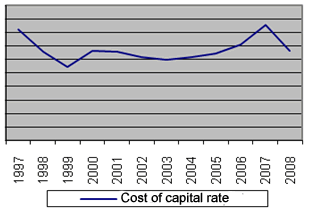As far as the time horizon is concerned, PTC refers that the definition of a cost-of-capital rate calculated on an ex-ante basis "aimed at fostering an environment of a lower regulatory uncertainty". The company adds that the Decision of February 2010 resulted in an "exaggerated regulatory determinism, preventing normal market fluctuations from being reflected on PTC's cost-of-capital rate accurately and on time, in the case of fixed parameters, and leading to the launch of an administrative process which turned out to be time consuming and disproportionate relatively to reviewable parameters. ICP-ANACOM's approach created the conditions, on the one hand, for abrupt reviews of the cost-of-capital rate, after the period which ICP-ANACOM's determination concerns and, on the other hand, for the need to make ad hoc updates, whenever extraordinary situations affecting assumptions considered occurred, which was the case in every year in which ICP-ANACOM's determination was in force (2009 to 2011)".
As regards the cost-of-capital rate, PTC refers that "the regulatory uncertainty concerning this component of costs of regulated products cannot be removed by administrative means and for limited periods of time (3 years), and a methodology that allows that every year parameters are brought in line with the market evolution should be addressed, through a set of rules that are simple to apply, transparent and affordable."
This operator also highlights that the determination of the cost-of-capital rate must reflect "effectively the actual market conditions in each moment, without requiring every year a new specific decision on the subject, with all the consequences at the level of efforts of analysis, preparation and participation in the respective consultation process".
PTC mentions also that, taking due regard to the macro-economic conditions verified, other parameters of the cost-of-capital rate, such as the risk premium, debt premium, the beta factor and gearing, should also be liable to changes. This change is due to the fact that parameters listed above were calculated on the basis of data from 2008, which are now out of date. However, PTC fails to suggest any alternatives for amending the methodology or to update the values for these parameters.
Lastly, PTC restates the importance of "strict compliance with deadlines defined, so as to minimize the operational impact of its implementation for all involved", adding that "PTC requested on 4 March 2011 the review of the cost-of-capital rate, thus meeting the established deadline, ICP-ANACOM, after the hearing procedure to interested parties, issued its final determination on this matter only on 26 August 2011 (…)".
ICP-ANACOM disagrees with PTC's interpretation according to which the current methodology for determining the cost-of-capital rate favours abrupt reviews of the cost-of-capital rate. In fact, it can be easily noted that the methodology followed earlier by PTC led to significantly volatile rates, notwithstanding the fact that the macro-economic context at the time was significantly more stable and predictable than that in 2009 and 2011, with rates between 1997 and 2008 being in a range between 11% and 17% (vide chart I and table I).
Chart I - Evolution of PTC cost-of-capital rate 1997-2008

Source: PTC AAS 1997-2008
|
|
1998 |
1999 |
2000 |
2001 |
2002 |
2003 |
2004 |
2005 |
2006 |
2007 |
2008 |
| Deviation relatively to the preceding year |
-3.21% |
-2.30% |
2.39% |
-0.21% |
-0.77% |
-0.36% |
0.45% |
0.45% |
1.32% |
2.97% |
-3.91% |
Source: PTC AAS Results 1997-2008
ICP-ANACOM stresses that the Decision of February 2010 had the effect of reducing substantially the uncertainty and volatility of this cost component (see chart and table above) while bringing into line every year the main parameters of the cost-of-capital rate, as the current review process shows. This Authority thus considers that, although it may be assessed in separate how the methodology defined could be improved, namely when defining rules for calculating the cost-of-capital rate for the next regulatory period, the Decision of February 2010 was an effective procedural improvement, when compared to the practise followed to that date.
Lastly, and notwithstanding the fact that ICP-ANACOM agrees with the need to accelerate decision-making procedures, it must be referred that data underlying the calculation of the risk-free rate parameter (10-year Treasury bonds) which PTC wishes to be updated, are available since the beginning of 2012, having PTC requested this review by letter of 29 February 2012.




